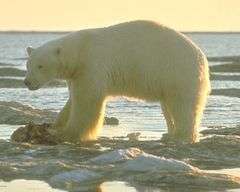Thousands of viewers from around the world are expected to log-on to "Tundra Connections" this week, to participate in free, live webcasts from the tundra of Western Hudson Bay, featuring leading experts and wild polar bears via remote video cameras.
Over 30 segments will be broadcast from onboard ‘Buggy One', a tundra vehicle that has been specially-equipped with high-speed internet, cameras and stabilizers for beaming live clips of polar bears in the wild. During video conferencing from this mobile classroom, participants can ask questions of the experts in real time. Teacher lesson plans are also available for free.
As Buggy One roams a network of established trails within the Manitoba Conservation, cameras mounted on the outside of the Buggy broadcast any bears nearby, and the experts break from their prepared talks to comment on what the viewers are seeing. The audience is often treated to polar bears sparring, mothers with cubs and curious bears who may nuzzle up to a camera.
This is the time of year that the polar bear population of Western Hudson Bay moves from their summer home on land, to the shores of Hudson Bay where they anxiously wait for the winter sea ice to form.
"This is a crucial time for the polar bears. They've been fasting for the summer months and they need to return to the sea ice to hunt seals, their primary food source," said Julene Reed, an Apple Distinguished Educator responsible for directing Tundra Connections. "So there couldn't be a more appropriate time for Polar Bears International to reach out to the community, schools, zoology professionals, government and the entire world to educate and inspire people about how to conserve polar bears and their arctic habitat."
Tundra Connections is one of many programs coordinated by Polar Bears International from Churchill, Manitoba in October and November, during polar bear migration season in Canada.
"We're so excited by the growing enthusiasm for this educational tool," said John Gunter, general manager of Frontiers North, a partner in producing the Tundra Buggy Adventure vehicle. "What's cool about sponsoring Tundra Connections is that Buggy One now allows us to deliver our message about the importance of conserving bear habitat anywhere there's an internet connection."
Studies released this year by research teams from the University of Alberta show that the Western Hudson Bay polar bears may face rapidly declining numbers in the next few decades due to climate change and shrinking sea ice. The average body condition and reproduction rates of these polar bears has been declining for almost 30 years, and projected sea ice models forecast this population could reach a point within the next three decades where there are too few animals to sustain a breeding population.
"We'll be watching closely for the dates these bears are able to return to the sea ice," added Dr. Derocher. "Twenty years ago, the average date the bears returned to the ice was November 8. A decade ago that date stretched to November 20. And in 2009, the bears were forced to wait until the first week of December before the sea ice formed. "
"The most important thing that we as experts need to communicate is that there is hope. We can help stop the effects climate change is having on the arctic and polar bears. It starts with programs like Tundra Connections which can educate individuals, companies and government about how to make positive changes to help lower their carbon footprint."
Tundra Connections, is a collaboration with Apple Education, Dr. Jane Goodall's Roots & Shoots, and Discovery Education.
Check out Tundra Connections 2010 for the program schedule, to watch the webcast, get the viewing information, and complete list of panelists: www.polarbearsinternational.org/tundra-connections-webcast










Be the first to comment